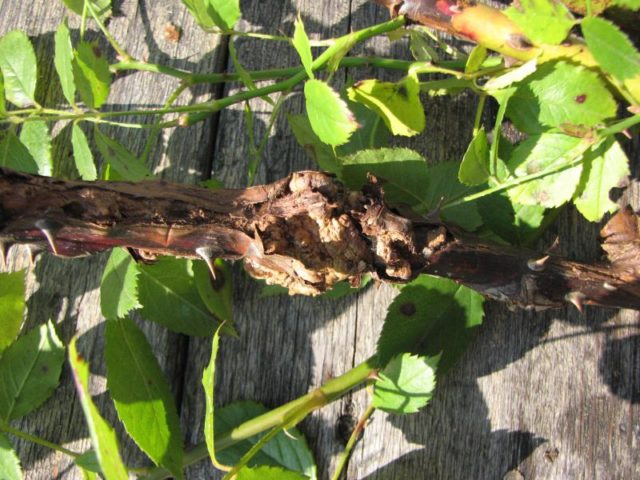 One of the most dangerous bacterial diseases that roses are susceptible to is bacterial cancer. Many gardeners, when they detect symptoms, refuse to reanimate the affected plants.
One of the most dangerous bacterial diseases that roses are susceptible to is bacterial cancer. Many gardeners, when they detect symptoms, refuse to reanimate the affected plants.
This approach is largely justified: the complexity of treatment, the serious consequences and the contagiousness of the disease make it appropriate to destroy the sources of infection. But in the early stage, bacterial cancer in rose bushes is curable, although there is no guarantee of a positive result of therapy.
Content
Signs and causes of bacterial cancer
There are two diseases of the rose, which are called bacterial cancer, but they are caused by different pathogens. In both cases, the state of the plants will be seriously damaged; it can lead to the death of bushes. A more dangerous form of the disease is cancer, which affects the roots of roses.
Bacterial root cancer
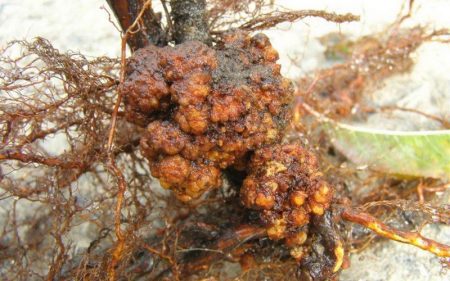 The disease causes the bacterium Agrobacterium tumefaciens, which lives in the soil. A microorganism can enter the soil along with water, infected seedlings or garden tools during digging and cultivation. The bacterium can remain viable outside the plant's body for 3-4 years. The microorganism penetrates into the tissue of the rose only through cracks or cuts, therefore, a necessary condition for the development of root cancer is damage to the roots due to transplantation, careless loosening or damage by soil pests (the bear, the chafer beetle larva and others).
The disease causes the bacterium Agrobacterium tumefaciens, which lives in the soil. A microorganism can enter the soil along with water, infected seedlings or garden tools during digging and cultivation. The bacterium can remain viable outside the plant's body for 3-4 years. The microorganism penetrates into the tissue of the rose only through cracks or cuts, therefore, a necessary condition for the development of root cancer is damage to the roots due to transplantation, careless loosening or damage by soil pests (the bear, the chafer beetle larva and others).
The causative agent provokes chaotic cell division, as a result of which tuberous growths grow on the roots and root neck. Rarely, tubercles appear even on the stems. The growths can be of any shape and size, over time they grow and rot. As a result, the vessels in the root tissues are destroyed, which complicates the flow of moisture and nutrients from the soil to the upper part of the bush. Suspect the disease can be a deterioration in the general condition of plants - roses weaken, grow more slowly, over time, the bush dries.
The difficulty in diagnosis makes the disease especially dangerous - the symptoms that appear on the aerial part of the bush are not specific. Characteristic swelling on the root neck, which the gardener, as a rule, guesses about the cause of depletion of the bush, appears when the root system is completely affected by the disease.
By the growths on the roots, you can determine the stage of the disease. Recently arising swellings are light in color and soft tissue, they gradually harden, acquiring a "woody" structure and a dark shade. In the late phase of the lesion, the growth begins to rot.
Bacterial cancer often affects old rose bushes, the roots of which are more susceptible to cracking and other damage. But the worst of the therapy is young plants.
The development of bacterial cancer in roses contribute to:
- Temperature in the range + 25 ... + 30 ° C. When increased to + 38 ° C, the pathogen does not show activity.
- Soil acidity in the range of pH 6–9. Once in acidic soil, the bacterium remains viable, but the disease does not develop.
- Clay soil. When growing on heavy soils, the likelihood of cracks in the roots is higher. This can happen in case of drying out or excessive moistening of the soil.
- Excess nitrogen. The rapid and intensive growth of plant cells due to excessive doses of the element leads to thinning of their membranes.As a result, the cell’s defense against the penetration of bacteria and viruses into it also weakens.
Bacterial stalk cancer
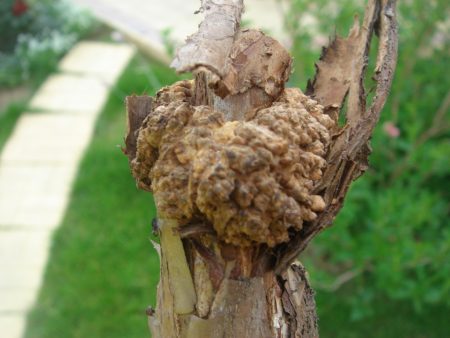 Stem cancer is aroused by the bacterium Pseudomonas syringae. Pathogens can enter the plant through air, water, pruning tools or vaccines that were not disinfected after working with a sick bush, the infection is transmitted through insects.
Stem cancer is aroused by the bacterium Pseudomonas syringae. Pathogens can enter the plant through air, water, pruning tools or vaccines that were not disinfected after working with a sick bush, the infection is transmitted through insects.
The bacterium tolerates low temperatures well, hibernates in plant tissues, becoming more active with warming. Bacterial cancer on the stems more often appears and begins to intensively progress in the early spring, when the roses are weakened. For infection with this type of bacterial cancer, stem bark damage is required, excess moisture in the soil is favorable for the disease, and rose immunity is reduced due to poor wintering.
Indented areas form on young stems, brown-brown ulcers appear under the bark. Over time, the bark in this place dies, the entire stem gradually dries. A concomitant symptom of stem cancer is the appearance on the leaves of watery spots of a dark shade. If the weather is dry, the central part of such a stain dries and the leaf cracks. In the case of the rainy season, the black spots expand until they cover the entire surface of the leaf plate. After that, the leaf falls from the bush.
Methods for the treatment of cancer of roses
Whichever of the two diseases affects the roses, treatment makes sense only at the initial stage of cancer development. With a significant development of the disease, you need to destroy the rose. Dug bushes, as well as remote areas of the plant, must be burned to prevent bacteria from spreading through the garden or flower garden.
Root cancer treatment
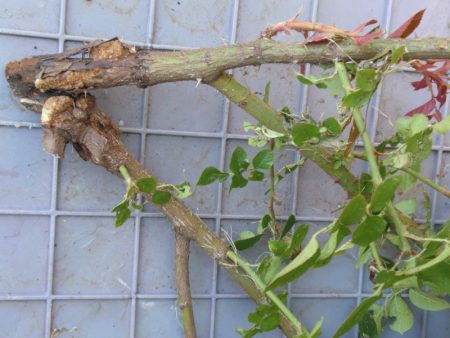 In the case of poor-quality treatment, there is a risk of transferring the bacteria to a new place during transplantation, so the gardener, choosing the salvation of the bush, must weigh all the risks and prospects of such a step.
In the case of poor-quality treatment, there is a risk of transferring the bacteria to a new place during transplantation, so the gardener, choosing the salvation of the bush, must weigh all the risks and prospects of such a step.
Treatment scheme for bacterial root cancer:
- The affected bush should be dug up and the roots washed with water, and then rinsed with a strong solution of potassium permanganate.
- Root processes on which formations appeared should be cut to healthy sites. After each cut of the fabric layer, the knife must be disinfected with alcohol.
- The roots of the bush remaining after trimming should be immersed for 2-3 minutes in a 1% solution of copper sulfate.
- Rinse the roots with clean water.
- To process places of cuts with alkyd paint. Allow to dry.
- Dip the roots in a mixture of sand and clay (thick consistency).
Experienced gardeners recommend adding the drug “Fundazole” to the paint, and “Heteroauxin” to the clay. In the first case, 5 g of powder should be poured into 10 ml of paint, mix and leave to infuse for 10-15 minutes. “Heteroauxin” is diluted 1 tablet per liter of the mixture.
- Plant a bush in a new place.
Stem Cancer Treatment
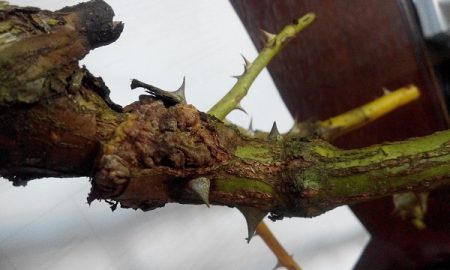 Small affected areas on the stems need to be cut, stripping sections to a healthy tissue. If the leaves are damaged, it is necessary to cut the entire stem 10 cm below the last spotted leaf. Sections should be disinfected with 5% copper sulphate and gloss over with linseed oil.
Small affected areas on the stems need to be cut, stripping sections to a healthy tissue. If the leaves are damaged, it is necessary to cut the entire stem 10 cm below the last spotted leaf. Sections should be disinfected with 5% copper sulphate and gloss over with linseed oil.
Even in the case of a successful outcome of the “operation”, the disease does not pass immediately, regular treatment of roses will need to be provided for about 3 years. During this period, you must:
- Regularly inspect the bushes and, if necessary, repeat the procedure for pruning damaged areas.
- In the spring (before the movement of juices), the bush should be treated with Bordeaux liquid (2%) or with Nitrofen (200 g of the product must be diluted in a bucket of water).
- After spring treatment, spray the rose with a solution of zinc sulfate (3 g per 10 liters).
- At the end of summer, feed the plant with an additional dose of potassium. A solution of 30-40 g of potassium sulfate or 20 g of potassium nitrate per 10 liters of water is prepared for irrigation. For spraying, 10 g and 5 g of the substance are diluted in the same volume of water, respectively.
- Before you cover the rose for the winter, the bushes need to be sprayed with 2% Bordeaux fluid.
Preventative measures
 General preventive measures that will be effective against both types of cancer are strengthening immunity and endurance of plants. To do this, it is enough to provide roses with good care.
General preventive measures that will be effective against both types of cancer are strengthening immunity and endurance of plants. To do this, it is enough to provide roses with good care.
In addition, it is important to comply with sanitary rules to prevent bacterial and viral infections. All tools must be disinfected with alcohol, and sections on plants should be treated with garden varieties or potassium permanganate.
Root Cancer Prevention
Even contamination of the soil on the site with bacteria does not mean that the disease will develop. The lifespan of the root cancer pathogen in roses is 3-4 years. If during this period the bacterium does not find a host plant, it will simply die. Therefore, in caring for roses, it is recommended to adhere to the rules:
- Do not plant rose bushes in areas where this or other crop roots susceptible to bacterial cancer have already grown less than 5 years ago.
- Avoid planting roses near potentially vulnerable plants. On the contrary, sowing cereals in the flower garden reduces the risk of disease.
Bacterial root cancer affects crops such as grapes, cherries and cherries, apple trees, pears, apricots, raspberries.
- To remove soil pests.
- Give the last nitrogen supplement no later than mid-June.
- Put shelter for the winter only in dry weather.
Stem Cancer Prevention
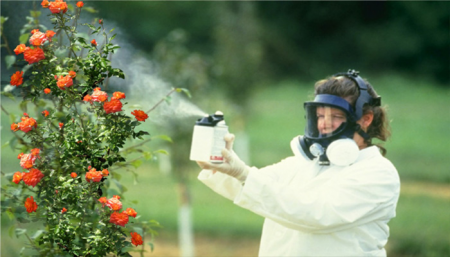 The gardener has more opportunities to prevent this disease - since the disease affects the aerial part of the bush, preventive treatment with drugs will be effective. Such sprayings are carried out 2 times a year: in the spring, before the buds open and in the fall, before placing the roses in a shelter.
The gardener has more opportunities to prevent this disease - since the disease affects the aerial part of the bush, preventive treatment with drugs will be effective. Such sprayings are carried out 2 times a year: in the spring, before the buds open and in the fall, before placing the roses in a shelter.
Effective remedies:
- copper sulfate (1%);
- Bordeaux liquid (2%);
- copper oxychloride (0.4%);
- drug "Topsin-M" (0.2%);
- Nitrofen (2%).
In addition, it is important to carry out annual pruning during the dormant period. It can be spring or autumn, but at this moment there should be no movement of juices. The bacterium that got into the bush tissue when it is trimmed along with the juice spreads faster throughout the plant.
Resistant varieties
Varieties of roses, uniquely resistant to stem and root cancer, do not exist. But spray roses are much less likely to be affected by bacterial root cancer than climbing varieties. It was also noticed that park roses show a high tendency to stem cancer.
Tips and reviews of gardeners
Anastasia, 36 years old:
“Cutting the roots helps. My bush even bloomed repeatedly, although the flowers were very small, and there were few of them. But I was ready for the bush to be destroyed. By the way, nowhere do they write how to dig diseased plants correctly. If the bush is damaged by stem cancer or any fungus, before I take it out of the ground, I personally cut off diseased leaves and branches, disinfect my instruments and hands, and then dig the roots. In this way, we minimize the risk of spreading the infection to other plants. ”
Elena, 48 years old:
“Faced with bacterial cancer on the roots of a rose several years ago, I wondered what to do with the infected area. Here is my experience: you need to pour a few buckets of boiling water on the place where the diseased plant grew, after which the bacterium must die. It is also possible to acidify the soil (but this reduces the number of crops that can grow in this place). A solution of citric acid or vinegar is suitable for this. In a bucket of water I dilute 2 tablespoons of acid or 100 ml of vinegar (9%). I pour 1 bucket per square square. Peat seems to me a weak remedy in terms of killing bacteria, but more useful for the soil. "
In order to increase the acidity of the soil, by 1m2 1.5-2 kg of peat or 70 g of sulfur should be added and dug up.
Maria, 51 years old:
“There have been cases of purchase of infected planting material, so now I treat seedlings with antibiotics. I usually take Cefotaxim for this, I dilute 1 gram in a liter of water. The seedling must be immersed in the resulting solution completely and kept for about an hour. The causative agents of cancer, like any bacteria, are vulnerable to such drugs. I have no such problems anymore. ”
Olga, 40 years old:
“My rose with bacterial cancer grew in a flower bed, surrounded by other plants. The bush removed, but did not dare to make a fire in this place or to undertake any manipulations with the soil because of the plants surrounding it. As a result, she took out the old soil, replaced it with a new one. “I decided to plant ornamental cereals on this site for the period of quarantine - both beautifully and cereals are invulnerable to this infection.”
Bacterial root cancer can be fought, but it makes sense to treat and preserve only the most valuable plants for the gardener. The likelihood of saving rose bushes is much higher in the event of bacterial cancer of the stems, but it is important to continue treatment for several years. In both cases, the main fight against the disease is prevention.




 Shelter of roses for the winter: at what temperature does the robot hold
Shelter of roses for the winter: at what temperature does the robot hold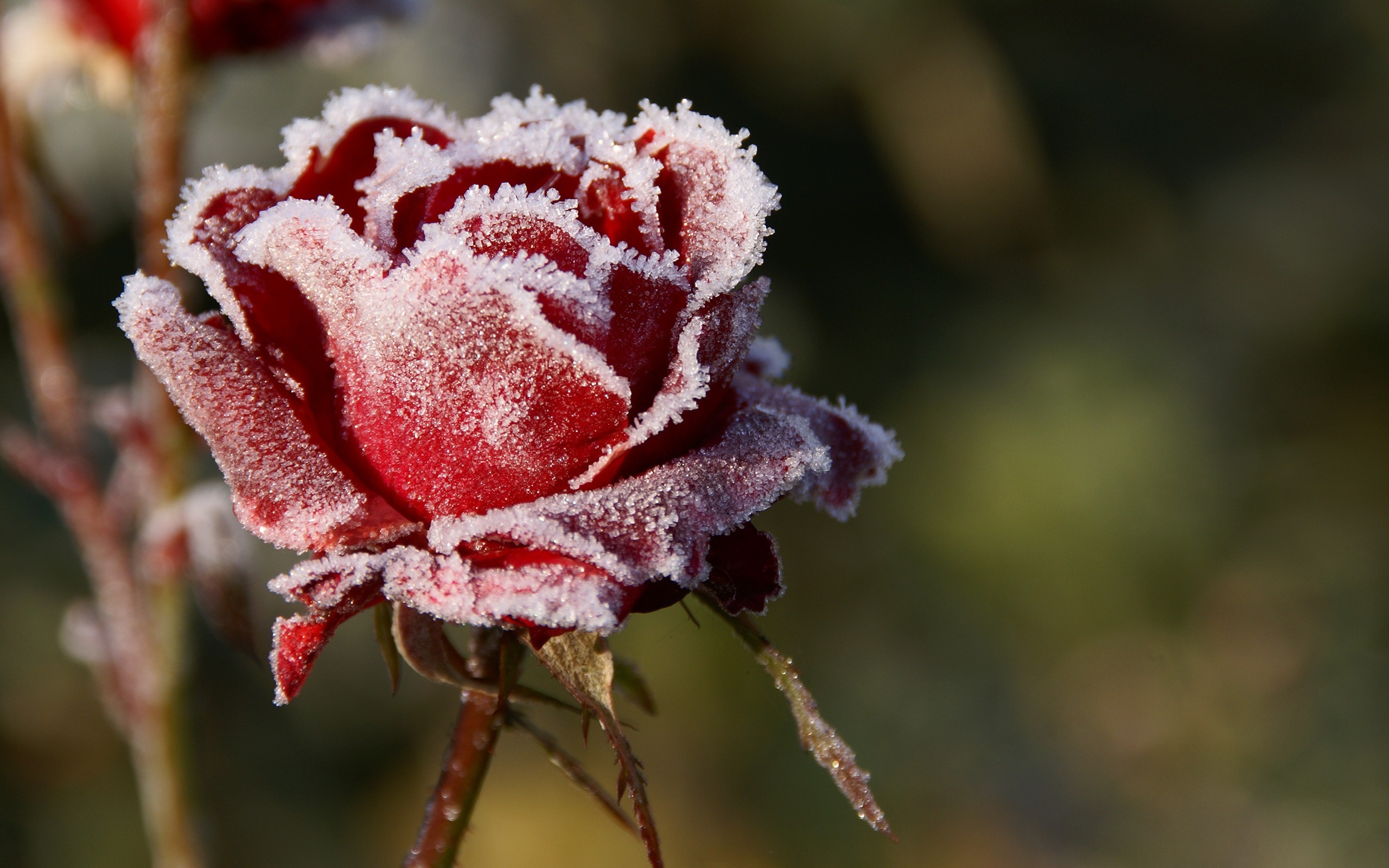 How to prune roses in the fall: timing, pruning rules, pros and cons
How to prune roses in the fall: timing, pruning rules, pros and cons What are the varieties and types of roses
What are the varieties and types of roses How to process roses with iron sulfate in autumn: proportions, advantages and disadvantages
How to process roses with iron sulfate in autumn: proportions, advantages and disadvantages
Andrei
And why do people not know the cause of cancer? In plants, everything is obvious, because of bacteria ... They tell us about certain mutations, but mutations each work differently ... But cancer cells have immortality, and they can metastasize. In short, it treats clarithromycin 500 mg 2 times a day for 20 days.